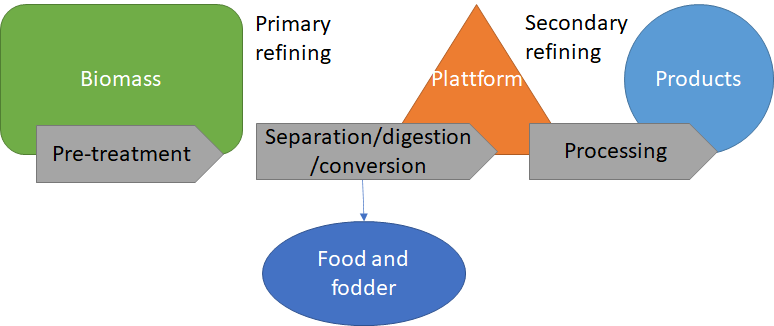7. Biorefinery concept
| Website: | Hamburg Open Online University |
| Kurs: | Process engineering for the bioeconomy |
| Buch: | 7. Biorefinery concept |
| Gedruckt von: | Gast |
| Datum: | Mittwoch, 10. Dezember 2025, 22:50 |
Beschreibung
Find out everything about biorefineries in this book.
7. Biorefinery concept
Biorefineries try to extract as many valuable substances and products as possible from biomass using a technical system. With this zero-waste approach, they represent the concept of the bioeconomy in perfection. The product range extends from chemicals to biofuels.
What you should know:
- Biorefineries use various chemical or physical processes to break down and refine biomass
- some biorefinery concepts are still at the experimental stage, others are already in commercial operation
- Commercial plants often produce biofuels as their main product
- Biorefineries can be classified according to the raw materials used: starch, sugar, oil or lignocellulose
A biorefinery consists of different biochemical, mechanical or thermochemical processes that are applied one after the other or side by side, each of which must be adapted to the biomass to be processed. There is therefore no one biorefinery, but different ways and possibilities to realize the biorefinery concept. A distinction is made between two basic approaches:
- A bottom-up approach is when existing biomass processing plants are expanded with additional process steps in order to extract valuable substances from existing waste. For example, a fruit juice production plant can add processes for extracting oils or pectins from the peel of the fruit, process the waste into fertilizer or produce biogas from it.
- In contrast, the top-down approach is based on a completely redesigned plant concept that uses coordinated process steps to extract as much valuable material as possible from a particular biomass.
However, some basic process steps can be found in all biorefinery concepts. They are shown schematically in Figure 1 and are briefly described below.
Basic process steps
Mechanical processes are used for pre-treatment (shredding or cleaning of the biomass, removal of impurities).
Mechanical separation, chemical or biological digestion or thermochemical, biochemical conversion into so-called platforms (intermediate products) are the first refining step (primary refining). Processes such as extraction, treatment with strong acids or bases, gasification or fermentation can be used for this purpose. Important platforms are e.g. C5 or C6, sugar, oils, lignin, synthesis gas or biogas.
The platforms produced can then be further processed into marketable chemicals, materials or energy (secondary refining). Food or animal feed is usually already obtained in the primary refining step.

7.2 Commercial application and research
Commercial application
Commercial applications are mainly found in processes that are either based on the production of biofuels or highly marketable products such as cellulose, sugar or starch.
This website provides a nice overview and interactive graphics on the processes, locations and biomass used by biorefinery plants in Europe.
The following table was created using information from the website. However, the site offers many other evaluation options.
| Feedstock | Origin of biomass | Plattform | Number of plants |
| Sugar plants | Primary: 91%, Waste: 9% | C6 Sugar | 43 |
| Strach plants | Primary: 87%, Waste: 13% | Starch | 43 |
| Öl plants, used cooking oil | Primary: 85%, Waste: 15% | Oil | 71 |
| Wood | Primary: 66%, Waste: 34% | Pulp and waste liquor | 60 |
| Lignocellulose plants | Primary: 63%, Waste: 37% | C5 & C6 sugars and lignin | 33 |
Examples of sugar and starch biorefineries
Verbio produces biogas, bioethanol and biodiesel from agricultural lignocellulose biomass (straw), grain and rapeseed, as well as animal feed and fertilizers and high-quality biocomponents for the pharmaceutical, food and chemical industries.
Crop Energies a subsidiary of Südzucker, produces bioethanol, neutral alcohol, food and animal feed, biogenic CO₂ and biochemicals for the cosmetics, pharmaceutical and chemical industries from sugar beet and grain.
Examples of wood-based biorefineries
UPM Biochemicals produces wood-based glycols and lignin-based functional fillers (RFFs) that can be used in the production of textiles, PET bottles, packaging, refrigerants, composites, rubber and plastics.
Lenzing produces pulp and fibers from wood for the production of textiles and nonwoven products.
Examples of oil- and fat-based biorefineries
Nesteproduces biodiesel and biokerosene as well as polymers and chemical products from used fats and animal waste.
Research and innovation
- A Hamburg start-up extracts lignin in an environmentally friendly way and processes it into functional spherical particles for the cosmetics and food industries: https://www.lignopure.com/
- Overview of research projects in the field of biorefineries: https://www.biosc.de/bioraffinerien
- Fraunhofer Research Biorefinery Leuna: https://www.cbp.fraunhofer.de/de/publikationen/broschueren.html (Organosolv process, utilization of lignocellulose)
- Overview of biorefinery research and plants, various plant concepts: https://biooekonomie.de/themen/dossiers/bioraffinerien-nachwachsende-rohstoffe-effizient-nutzen
- Findings on the topic of algae biorefinery, which were gained in a joint project: https://www.igb.fraunhofer.de/content/dam/igb/documents/publications/berichte/2016/2016_Algen_Bioraffinerie.pdf